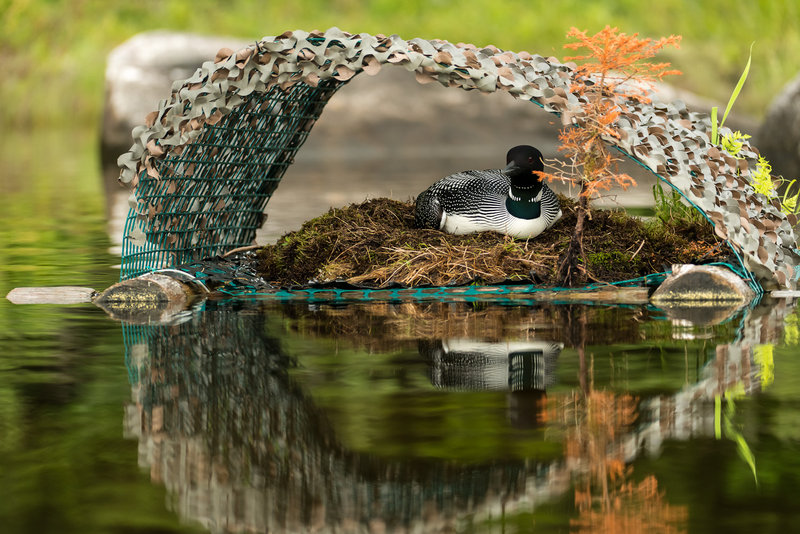A Gorham research organization is tracking loon populations, not just in Maine where the birds are iconic, but all over the continent, from Alaska to Mexico.
While many may think The Biodiversity Research Institute in Gorham largely focuses its studies on New England flora and fauna, the fact is that their work on loons extends much farther.
Ever since it was established in 1998, the Biodiversity Research Institute in Gorham has given attention to loons, expanding their studies to include habitats in New York’s Adirondack Mountains, Washington state, Alaska, Montana, Louisiana, and Mexico. Most recently, BRI has also undertaken work with Yellowstone National Park in Wyoming, said Jim Paruk, director of the institute’s Center for Loon Conservation.
Overall, the nonprofit research and education institute is finding that the health of loons is holding strong, a good sign for humans, too. Loons are birds near the top of their food chain and also consume some of the same foods as humans do. This means that studies of their health yield valuable information about how toxic contaminants might be moving into and through the human food chain, said Paruk.
And then, there’s just this: Loons are beloved, especially here in Maine.
“Yes, I do love them,” said Phyllis Coelho of Belfast, treasurer for Mid-Coast Audubon Society. From an aesthetic standpoint, she called attention to the “sheer beauty and their call, which is the highest note of grief,” she said.
Loons have four distinct vocalizations: a yodel, a hoot, a tremolo and a wail. The tremolo and wail are the two calls most often associated with the bird, and Coelho finds in them the elemental voice of wilderness (tremolo) and the sound of mourning (wail).
“It raises emotion in people,” she said. The vocalizations, which she described as “profoundly, incredibly, beautiful,” have an evocative quality for those who hear them.
“At first, you might not even think it is a loon,” she said. “You’d almost think it was an animal in distress. But after awhile, you wait for it. Sometimes it comes in the middle of the night, sometimes in the morning,” she said. “It’s dramatic.”
Qualities like this make the loon a relatively easy sell as a research subject. “If you look at birds that are inspirational, not all birds are created equal,” Paruk said. “There’s no ambiguity, there’s no confusion, when we see a loon.” Something about its crisp, bold color and patterning appeals to the human craving for order, he said.
Paruk’s research on loons in the Gulf of Mexico in Louisiana represents the first time the birds have been captured and studied there, he said. The institute’s work, started in 2011, has focused on potential damage from the 2010 BP Deepwater Horizon well oil spill. It examines the winter ecology of loons and monitors for the presence of hydrocarbons in the birds’ blood. The pollutants are injurious to all wildlife, Paruk said, and can touch off “cascading side effects” that are devastating to the body systems of affected birds and animals.
Hydrocarbons are “in the loons,” said Paruk, “but we’re not finding very high levels.”
In Yellowstone National Park, research is still in the initial phases, with most of the energy going into creating a reliable, standardized database for all information about loon populations there that has been collected anecdotally over decades of observation.
The BRI began participating in the project last summer, and it will continue throughout the 2013 season. But it will be some time before the data will provide a historical perspective that is comprehensive and continuous enough to draw conclusions about patterns within populations.
While the institute’s loon studies began with monitoring mercury contamination in the common loon in New England and New York, newer research efforts have expanded to additional species — such as red-throated and yellow-billed loons. Further, the studies have broadened to incorporate analysis of effects of lead — the material targeted in recent Maine legislation limiting the use of lead fishing gear and banning sales of lead sinkers and lures beginning Sept. 1, 2016. Such gear will be prohibited from use starting the following year. Lead-covered lures still will be allowed, but no lead will be allowed in sinkers.
“Lead’s toxic to wildlife and humans,” Paruk said, adding that the new law is not so much a victory as an important step forward in eliminating toxins and embracing a conservation ethic for the state.
But neither lead nor mercury is the only problem for loons on Maine lakes, Paruk said. Studies of Rangeley Lake loons have continued for nearly 20 years and have verified that fluctuating water levels are the biggest threat to loon reproduction there.
In some cases, the water level in Rangeley has shown a 12- to 14-inch variation within two weeks in summer, and nests can be either flooded out or left high and dry. The development of loon platforms that can ride out the changes and keep the nests intact have led to greater breeding success, Paruk said.
What lies ahead are continued monitoring of the toxic pollutants and tracking emerging threats to loons from unfolding issues resulting from human-induced climate change.
These issues are just the sorts of challenges Coehlo hears in the mournful tone of the loon’s call. “It’s total, total grief for its natural habitat being sliced and diced and completely destroyed,” she said.
“Maybe (it’s) even a call to wake people up to what we’re doing to the world.”
North Cairn can be contacted at 791-6325 or at:
ncairn@pressherald.com
Send questions/comments to the editors.


